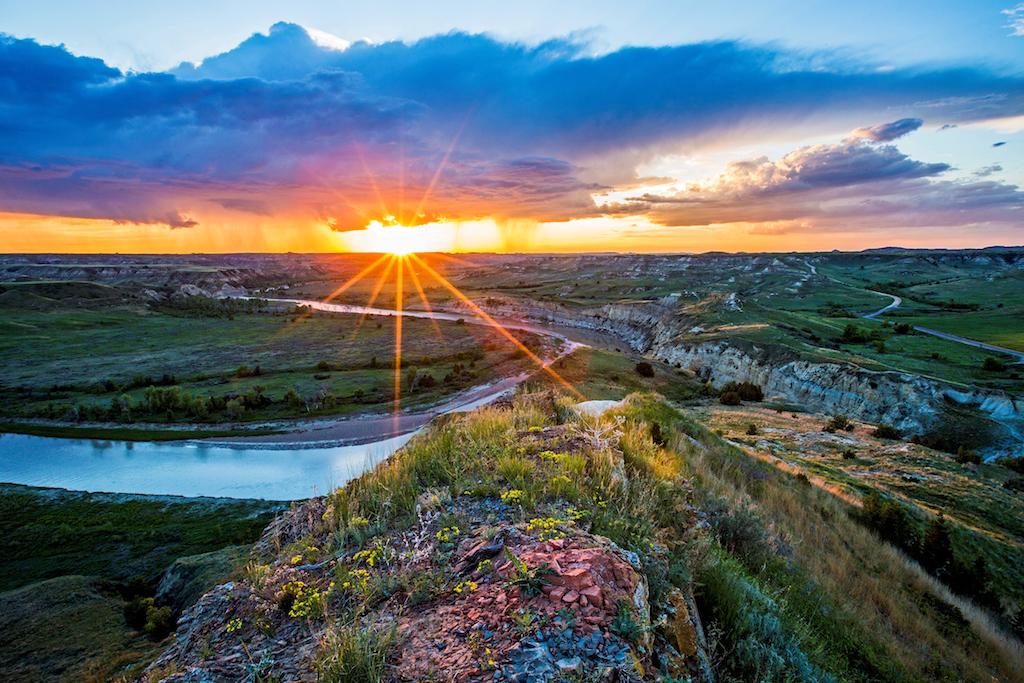
Oil exploration and refining on the lands surrounding Theodore Roosevelt National Park pose a threat to the park's health/NPS
Editor's note: Valerie Naylor, a former superintendent of Theodore Roosevelt National Park, asks that we remember and embrace President Theodore Roosevelt's conservation vision.
In 1910, Theodore Roosevelt stated, "Of all the questions which can come before this nation…there is none which compares in importance with the great central task of leaving this land even a better land for our descendants than it is for us." More than a century later, as we celebrate the 70th anniversary of Theodore Roosevelt National Park, this comment rings true, though shrouded in irony.
The last 10 years in particular have challenged the sanctity of President Roosevelt’s namesake park in western North Dakota, a place that stands as a testament to our country’s conservation legacy and the very president who helped shape it. Just outside the park are drilling rigs, pump jacks, and noise and traffic related to energy development projects. Infrastructure proposals such as a new bridge crossing over the Little Missouri River and a four-lane highway through the park’s North Unit add to the threats. And if the biggest oil boom in the United States in the last 50 years was not enough for Theodore Roosevelt National Park to endure on its borders, Meridian Energy Group has proposed a 55,000 barrel per day oil refinery, just three miles from the park’s boundary.
I first saw Theodore Roosevelt National Park in 1973, from the backseat of my parents’ 1965 Buick Skylark. As we drove through the park’s South Unit, I was amazed at the landforms. As we got farther into the park, I was even more enthralled - but my mother had the opposite reaction. She found it desolate and isolated, and asked to leave. My father turned the car around, but I knew I would return some day.
Six years later, while paging through a booklet of volunteer opportunities with the Student Conservation Association, a job at Theodore Roosevelt National Park caught my eye. I was offered the position and spent five summers in the park, first as a volunteer and later as a park ranger and graduate researcher, during the 1970s-80s oil boom. During that time, one of the park’s biggest concerns was the color of the pump jacks and tanks seen from the park. Those impacts, while substantial, now seem relatively minor.
My early experiences in Theodore Roosevelt launched a 31-year career with the National Park Service. After a series of jobs in Organ Pipe Cactus National Monument, Big Bend National Park, Badlands National Park and others, I returned to Theodore Roosevelt National Park in 2003 as superintendent. It was a homecoming, returning as superintendent to the park which launched my career. The park was still the amazing, beautiful, expansive wildlife haven I had remembered. But trouble was on the horizon, in the form of the region’s third oil boom.
The last four years of my time as park superintendent was largely occupied working with and against oil companies whose work threatened park resources; we sought to achieve win-win situations that would allow for development while protecting the viewsheds, soundscapes and sanctity of the national park. There were victories, failures and compromises. When I retired in 2014, the oil boom was beginning to release its grip on the North Dakota badlands. Unfortunately, the proposed refinery now looms at the park’s doorstep.
Meridian Energy recently submitted its request to the North Dakota Department of Health for an air quality permit. It has already received zoning approval from the Billings County Commissioners and a water use permit is pending. If the air quality permit and some wastewater permits are issued by the State of North Dakota, construction on the refinery could begin immediately. But even if the proposed refinery somehow meets the stringent air quality standards required for a national park under the Clean Air Act, it should not be built so close to the park—impairing park views and threatening its resources.
In a famous call to action, Theodore Roosevelt encouraged individuals to “Do what you can, with what you have, where you are.” I don’t believe the American public wants an oil refinery within three miles of Theodore Roosevelt National Park, or any national park.
Regardless of where individuals live, they can tell Meridian Energy Group Chairman and CEO William Prentice to consider alternate locations in North Dakota. We also hope that Interior Secretary Ryan Zinke, who proudly brands himself a Theodore Roosevelt Republican, will join this chorus of opposition to the proposed location. Together, we can and must ensure that this area that inspired Theodore Roosevelt, and still inspires people today, is protected for future generations.
Valerie Naylor is the former Superintendent of Theodore Roosevelt National Park. To speak up for Theodore Roosevelt National Park, click here.



Comments
My favorite national park. Thanks for including the link to the NPCA.
I spent the last 42 years traveling through 49 of the 50 states. I visited probably 95% of the national parks. Theodore Roosevelt N P, north and South units, were the last parks I visited this month. While I was aware of the oil drilling in the region I must say that it did not diminish my visit. It was more noticeable when I drove from the south unit to the north unit when I passed the many trucks parked on the east side of the highway. Driving through the parks brought me to the most overwlmingly beautiful terrain and abundant wildlife. The fact that this region is remote and far from any congested cities allows the visitor to focus on its beauty and magnificence.
I hope that any progression in the drilling and refining keeps with the sanctity of this region and does not further encroach on it.
I am one who feels Godliness in nature.
Robert G